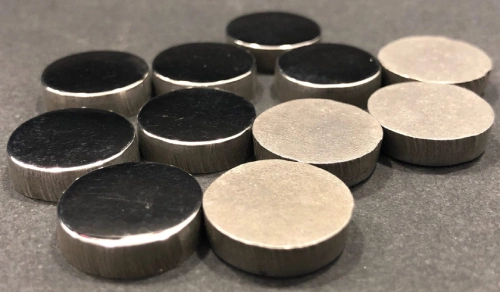Nickel, Aluminium, Zinc, Cobalt, Lithium, Copper, Tungsten, Chromium, Titanium for sputtering targets: non ferrous metals market overview and forecast; the impact on your sputtering target purchases.
Nickel:

Indonesia will probably overtake China as the world´s largest producer of nickel pig iron (NPI), a raw material for stainless steel production.
Effective January 2020, the largest nickel ore producers will cease exports from Southeast Asia. Will China’s NPI producers meet this raw materials shortage? China accounts for 50% of the demand for nickel, and 80% of this demand goes to the stainless steel sector.
Aluminum:

China’s production of primary aluminum is expected to grow much more quickly than its consumption in 2020. Aluminum production in China declined by 1.51% in 2019 YTD, but production will increase by 2.5% to 36.5 M T in 2020.
Consumption in China will rise at a slower pace: 0.3%, reaching 36.2 M T after a decline of almost 1.5% in 2019.
Zinc:

In October 2019, China’s zinc production increased by 529,000 T, reaching 4.77 M T, which represents a 7.75% increase.
However, China’s imports of refined zinc increased by 10.76% in the first 9 months. Over the forecast period, the global zinc supply is expected to grow at a compound annual growth rate of 3.8%, reaching 15.7 M T from 2019 to 2022. Demand is expected to reach supply level in 2022 and eventually transition to a market surplus within 3 years.
Cobalt:

Smelters in China reduced imports of raw materials after inventories shrank during the first three quarters of 2019.
Demand is expected to increase by 4% in 2019 to 137,200 T, while supply will remain constant at 163,500 Tt.
Before the release of 2020’s subsidies for new energy vehicles and new demand from the 5G mobile sector, prices will rise by 270,000-300,000 yuan/T in 2020.
Lithium

This key material for batteries will continue to increase following increased production of electrical vehicles.
Forecasts suggest that electric vehicles will account 40% of total car sales in China by 2030. They are estimated to reach 20% in 2025.
However, lithium stocks increased worldwide as they did in China during the second half of 2019. In 2017, Lithium prices led to mining investments in Australia to increase supplies of lithium ore. Global stockpiles of lithium ore reached 136,000 T of lithium carbonate equivalent (LCE) by mid-2019, and capacity in China stood at 550,000 T LCE in 2019.
Copper:

Rising overseas copper imports to China boosted the negotiation capacity of Chinese smelters. Prices are expected to remain steady. In China, refined copper output from recycled sources fell in 2018 and might fall again in 2019 with the full implementation of the metal waste import ban. Delays in mining growth capacity were observed in 2019, yielding a best-case scenario ratio of 2.2% for 2020-2021. Global copper refinery capacity is expected to reach a maximum of 27.5 million T in 2019.
Tungsten:

China still accounts for about 85% of the world’s supply, and Russia is far below in second place. After peaking in 2012, tungsten prices declined to 2005 levels. Due to market uncertainties, the second-quarter tungsten market was almost in panic, and 2019 saw a drop of more than 15% compared to same period last year. The average price for the first quarter in the European market was down by 16.10%. The price of tungsten concentrate is lower than the cost of mining and separation, and the mining enterprises have suffered serious losses. The market supply of tungsten raw materials will tighten as natural production reduction can be seen in most mines, and some mines have shut down as result of severe floods. However, as there is not much room for tungsten prices to decline, the market should remain stable.
Chromium:

Chromium is traded on the world market in the form of ferrochromium, an iron-chromium alloy. The price of ferrochromium reached historically high levels in 2008, and then declined in 2009 with a weakening world economy. During the same period, China’s role as a chromium consumer grew with its expanding stainless steel industry. Roughly 36 million tons of chromite was mined worldwide in 2018. Rich South African deposits accounted for around 44% of this production (South Africa accounts for approximately 72% of ore reserves). The remaining 56% came from mines in Turkey (6.5 million tons), Kazakhstan (4.6 million tons), India (3.5 million tons), and other countries (4.5 million tons). Ferrochromium prices were approximately US$1.15/lb in early 2019.
Over the next 2 to 3 years, the chrome ore supply is expected to plateau or increase marginally, potentially softening prices. Chrome ore prices will continue to depend on the production expectations of stainless steel.
The increase in ferrochromium processing capacity in Asia (primarily Indonesia and India) is expected to drive ferrochrome supplies for the next few years. We expect prices to remain relatively constant in 2020.
Titanium:

Titanium production increased in 2018 along the entire supply chain. China remains the world’s largest sponge producer in terms of capacity and output (raw material for titanium alloys and ingots used in sputtering target production; it comes from the application of the Kroll process to rutile extracted from mines [TiO2]). Production significantly increased in the rust quarter of 2019 However, the majority of premium grade sponge was not used for PVD applications, but in high-end aerospace applications produced in Russia, Japan, Kazakhstan, and the United States. China still dominates melted products such as ingots used for PVD technology.
The price of Chinese sponge steadily increased during 2018 and Q1 2019, reaching its highest value since July 2017. Chinese titanium plate prices followed a similar trend but spiked to US$17.4/kg in October 2018, then decreased. Nevertheless, they remained at a five-year high throughout Q1 2019. Alloy plate prices are also high in the United States due to increasing demand from the aerospace sector. We expect the price to remain at current levels during first half of year 2020.

